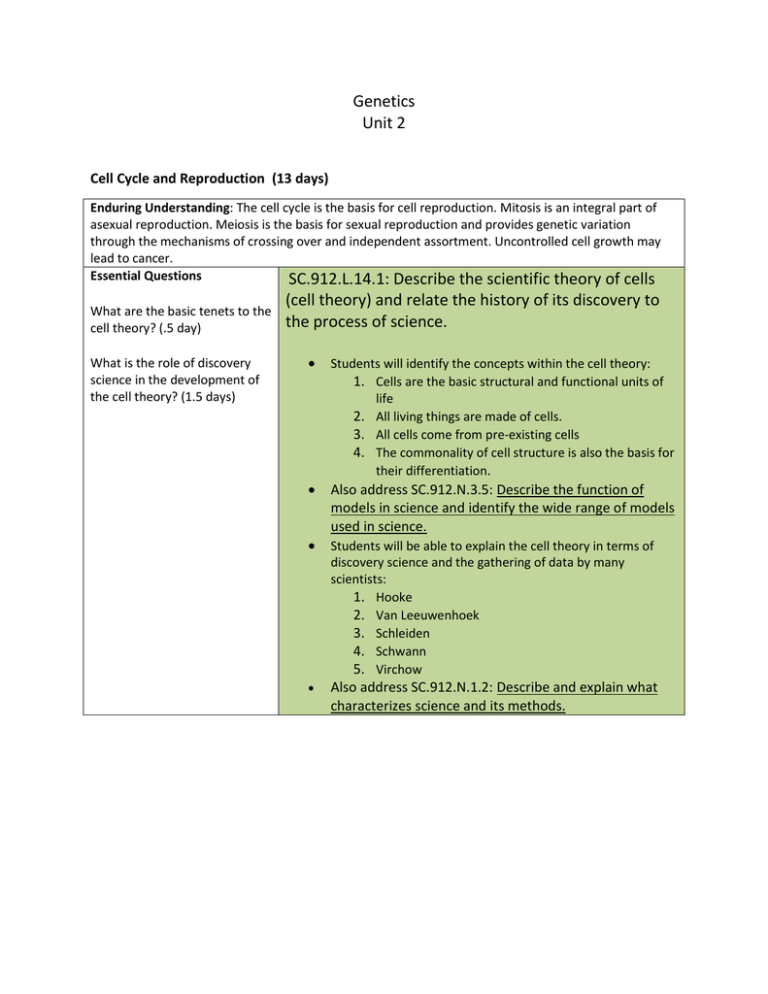GENE_CGT_UnitTwo_V03
advertisement

Genetics Unit 2 Cell Cycle and Reproduction (13 days) Enduring Understanding: The cell cycle is the basis for cell reproduction. Mitosis is an integral part of asexual reproduction. Meiosis is the basis for sexual reproduction and provides genetic variation through the mechanisms of crossing over and independent assortment. Uncontrolled cell growth may lead to cancer. Essential Questions SC.912.L.14.1: Describe the scientific theory of cells What are the basic tenets to the cell theory? (.5 day) What is the role of discovery science in the development of the cell theory? (1.5 days) (cell theory) and relate the history of its discovery to the process of science. Students will identify the concepts within the cell theory: 1. Cells are the basic structural and functional units of life 2. All living things are made of cells. 3. All cells come from pre-existing cells 4. The commonality of cell structure is also the basis for their differentiation. Also address SC.912.N.3.5: Describe the function of models in science and identify the wide range of models used in science. Students will be able to explain the cell theory in terms of discovery science and the gathering of data by many scientists: 1. Hooke 2. Van Leeuwenhoek 3. Schleiden 4. Schwann 5. Virchow Also address SC.912.N.1.2: Describe and explain what characterizes science and its methods. Essential Questions What is the cell cycle and its major stages? (1 day) What are the events occurring in the stages of mitosis and cytokinesis? (2 days) What are the functions of mitosis and the cell cycle? (.5 day) SC.912.L.16.14: Describe the cell cycle, including the process of mitosis. Explain the role of mitosis in the formation of new cells and its importance in maintaining chromosome number during asexual reproduction. Students will describe the parts of the cell cycle (G1, S, G2, Mitotic phase). The students will identify mitosis as division of the genetic material. Students will demonstrate the events occurring in the four stages of mitosis (Prophase, Metaphase, Anaphase, and Telophase). Students will describe the role of cytokinesis. Students will describe how a cell maintains the diploid chromosome number Students will describe the role of mitosis in growth, repair and asexual reproduction. Essential Questions How is the cell cycle regulated? (2 days) How is a cancer produced and what is the difference between a benign and a malignant tumor? (1.5 days) SC.912.L.16.8: Explain the relationship between mutation, cell cycle, and uncontrolled cell growth potentially resulting in cancer. Students will describe the three major checkpoints regulating the cell cycle: G1, G2, and M. Students will explain that the cell cycle is regulated by proteins called cyclins and cyclin-dependent kinases. Students will be able to demonstrate how the cell cycle regulatory proteins are themselves regulated by growth factors and tumor-suppressor genes. Students will be able to explain that mutations in the genes coding for any of the cell cycle regulatory proteins may alter the cell cycle leading to cancer. Students will describe how a mutated gene may be referred to as an oncogene. Students will compare the properties of a benign tumor and a malignant tumor. Essential Questions What is meiosis? (1day) Required Topic: Mitosis & Meiosis SC.912.L.16.16: Describe the process of meiosis, including independent assortment and crossing over. Explain how reduction division results in the formation of haploid gametes or spores. Students will be able to explain how meiosis has the same basic steps as mitosis repeated twice. How does crossing over contribute to genetic variation during meiosis? (.5 day) How does the independent assortment of chromosomes contribute to genetic variation? (.5 day) Required Topic: Mitosis & Meiosis – Suggested Lab: Biology Place Lab 3 Students will be able to define and identify sister chromatids. Students will be able to explain the connection between sister chromatids and crossing over. Students will be able to diagram crossing over and its importance (genetic variation) What is the importance of haploid cells in sexual reproduction? (.5 day) Students will describe the importance of the independent assortment of chromosomes during the first meiotic division. Students will describe the importance of the differences between the first and second meiotic divisions. Students will describe how meiosis results in the formation of haploid cells for sexual reproduction. Students will explain why a second Interphase does not occur between the first and second meiotic divisions. Essential Questions What are the similarities and differences between mitosis and meiosis? (.5 day) How is meiosis the basis for genetic variation during sexual reproduction? (1 day) SC.912.L.16.17: Compare and contrast mitosis and meiosis and relate to the processes of sexual and asexual reproduction and their consequences for genetic variation. How is mitosis the basis for asexual reproduction? (.5 day) Students will be able to summarize similarities and differences between mitosis and meiosis: 1. Number of divisions 2. Number of daughter cells produced 3. Chromosome number at beginning (parent cell) and end of process (daughter cells) 4. Crossing over occurrence Students will be able to explain how meiosis is a source of genetic variation through crossing over and the independent assortment of chromosomes (Meiosis I) for sexual reproduction. Students will describe mitosis as being the source of asexual reproduction.





